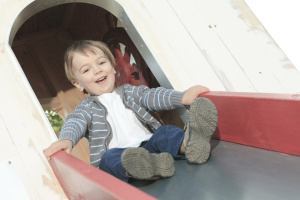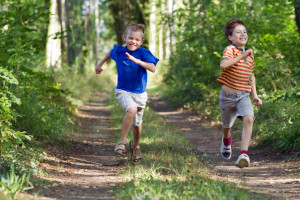 You teach your children to properly brush their teeth, get the right amount of sleep, and reach for fruit or other healthy option when they’re hungry. But what about movement? Granted, you don’t want your little one joining you for boot camp workout classes, but modeling positive fitness practices and providing your children with options is a great way to set the foundation for a lifetime of excellent health habits.
You teach your children to properly brush their teeth, get the right amount of sleep, and reach for fruit or other healthy option when they’re hungry. But what about movement? Granted, you don’t want your little one joining you for boot camp workout classes, but modeling positive fitness practices and providing your children with options is a great way to set the foundation for a lifetime of excellent health habits.
Young children are often naturally active. However, if your child could use more structured exercise, it might be time to make changes to the way you approach playtime. The National Association of Sports and Physical Education has developed some parameters for young children, including the amount of exercise that best meets their needs.
Why is Fitness so Important for Kids?
Gross motor skills are foundational to learning. More and more studies show that gross motor activities are instrumental in learning academic skills such as reading and math. As preschoolers, children have a strong need to use their large muscles frequently throughout their day. (We all know what life with a cooped up preschooler can be like!)
There are many benefits of including frequent large muscle activities throughout the day – including the development of the following skills: muscle memory, coordination, balance and spatial awareness. The body and the brain work together and both need to be exercised in order to grow physically and academically.
Is your child getting too much exercise, too little or just enough?
Goals to Follow
Children ages three to four are naturally inclined to play and an organized sporting event, tumbling class, dance class or anything else your little one adores is a great way to get them involved with other children their age. Children should also have at least 60 minutes of unstructured “free play” every day—and don’t worry, they’ll take care of this themselves. You might need to institute a no-tech zone and lead them to the playground, but they’ll do the rest.
As a rule of thumb, three-to-four-year-olds should never be inactive for over an hour, except when sleeping. However, deciding exactly what kids this age can do can be a challenge. A great approach is to introduce them to new things and let their preferences guide the course of activities. Striking this balance is an art, and one that we rigorously explore here at Kidspace.
Assessing Their Skills
Assessing simply means educating yourself on what the average child is capable of doing at various stages of development. For example, by the age of three, children are more able to balance their bodies and can throw a ball overhand and even catch it. Children at this age can also begin to master riding a tricycle.
Every child reaches these stages at his or her own pace, but by becoming aware of general milestones, you can begin to offer appropriate activities to your young one.
A Family Affair
 While it becomes important to introduce your children to team sports as they get older, family fitness is always an excellent way to bond and stay healthy together. This can include play in your yard or talking walking tours of your neighborhood. Explore a new playground every week, or practice moving like different animals. Songs like “Heads, Shoulders, Knees and Toes” have a built-in workout. Classical or Motown music can help get you and your child dancing, demonstrating your playful side while exposing them to music and movement that is fun and nurturing.
While it becomes important to introduce your children to team sports as they get older, family fitness is always an excellent way to bond and stay healthy together. This can include play in your yard or talking walking tours of your neighborhood. Explore a new playground every week, or practice moving like different animals. Songs like “Heads, Shoulders, Knees and Toes” have a built-in workout. Classical or Motown music can help get you and your child dancing, demonstrating your playful side while exposing them to music and movement that is fun and nurturing.
Vancouver Play Experts!
When it comes to fitness for little ones, any active practice counts. What physical activities have you and your child participated in today? If you’re looking for suggestions, our team at Kidspace Child Enrichment Center is always happy to help!

 Schedule Tour
Schedule Tour